


PHYSALIS
► ORGANIC PHYSALIS
► COOL PHYSALIS
DESCRIPTION
The fruit is a Berry with a diameter between 1.5 and 0.87-ovoid shaped weighs 4 to 6 grams. Their skin is smooth and bright. The fruit this covered with a membrane or fibrous sheath (calyx), fine not edible, which can be yellow or green color
••••••••••••••••••••••
MICROBIOLOGICAL SPECIFICATIONS Counts mesofilos 3000 UFC/g maximum yeasts and fungi 100 UFC/g maximum Total coliform N.M.P 200 UFC/g maximum fecal coliform N.M.P. 0
••••••••••••••••••••••
PHYSICO-CHEMICAL SPECIFICATIONS Measures 8.0-10.5 PH (20 ° C) at 20 ° C of juice NATURAL percentage of total solids (° Brix) 3.1 - 3.4 relationship Brix / acidity 3.5 - 10.0
••••••••••••••••••••••
TYPE OF TREATMENT
The gooseberry is subjected to the stages of receipt, storage, selection, Encestado, drying, packing and dispatch
••••••••••••••••••••••
CONDITIONS OF CONSERVATION Temperature: Between 8 - 10 ° C relative humidity: between 65-70%
••••••••••••••••••••••
CONSUME
This fruit is eaten raw as a grape, alone or with other fruits in salad or chocolate molten dessert, and as decoration of dishes. Also you can prepare jams, sauces or stuffings for delicious cakes, and decoration
••••••••••••••••••••••
USEFUL LIFE UNDER CONDITIONS OF CONSERVATION 27 DAYS
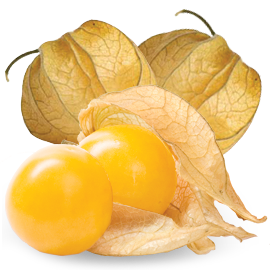
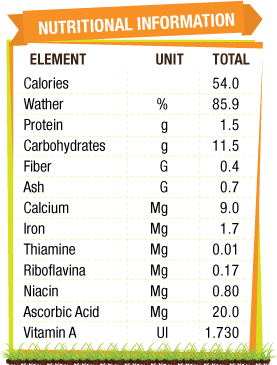
DESCRIPTION
The Baby banana, belongs to the family of the Musaceas. Its weight ranges between 60 and 80 grams and its size between the 10 and 12 cms in length. The shell is thin, smooth and yellow color, its pulp is soft and delicious, our bananito has an aroma of vanilla which increases its wonderful flavor.
••••••••••••••••••••••
MICROBIOLOGICAL SPECIFICATIONS
Counting Total of aerobics (SPC) max. 5000 CFU/g. count of filamentous fungi: < 500 CFU/gram yeast count: < 500 CFU/gram counting total coliform: < 3 CFU/gram.
••••••••••••••••••••••
PHYSICO-CHEMICAL SPECIFICATIONS
Brix Max. 12 NTU pH 4.0 - 4.3 acidity 0.95 - 1.45 Color sweet amber, transparent.
••••••••••••••••••••••
TYPE OF TREATMENT
The bananito undergoes stages of receipt, storage, selection, classification, packing and dispatch.
••••••••••••••••••••••
CONDITIONS OF CONSERVATION
Temperature: Ambient relative humidity: environment. To avoid its maturation is recommended to ventilate it.
••••••••••••••••••••••
CONSUME
This fruit can be enjoyed raw, withdrew the crust and consumed the pulp. A delicious drink, can also be obtained by mixing pulp with milk and sugar.
••••••••••••••••••••••
LIFE USEFUL UNDER CONDITIONS OF CONSERVATION 12 TO 15 DAYS
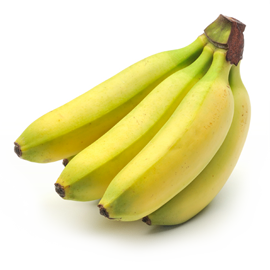

DESCRIPTION
The Feijoa belongs to the family of the Myrtaceas. Measures 7cms of length 5 and its form varies from round to oval, is a fruit of smooth or slightly rough bark and green when this mature; The pulp is white, granulation, watery, and has a translucent Centre with very small seeds just sensitive when eaten. Its taste is sweet, slightly acidic. Our feijoa emits a pleasant and lasting aroma.
••••••••••••••••••••••
MICROBIOLOGICAL SPECIFICACIONES
Count of Mesophiles (UFC/g): < 100 counts of fungi (UFC/g): < 10, Count Total yeasts (UFC/g): < 10.
••••••••••••••••••••••
PHYSICO-CHEMICAL SPECIFICATIONS
Brix degrees: 12 solids in suspension: 30-50%, acidity as citric acid: 0.4-0.8
••••••••••••••••••••••
TYPE OF TREATMENT
The feijoa is subjected to the stages of receipt, storage, selection, cleaning and disinfection, ventilation, packing and dispatch.
••••••••••••••••••••••
STORAGE CONDITIONS
Temperature: Ambient relative humidity: environment.
••••••••••••••••••••••
CONSUME
The feijoa is consumed raw, but is also often used to prepare compotes, jams, juices and jellies. Because of its somewhat acidic and refreshing taste, this fruit becomes the ideal for combining with other exotic fruits in delicious salads.
••••••••••••••••••••••
USEFUL LIFE UNDER CONDITIONS OF CONSERVATION 10 DAYS
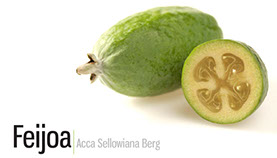

DESCRIPTION
The fruit has a hard shell with an almost spherical shape of 6-7, 8 cm in diameter, which in most cases has small white points. The fruits are enlarged to a 3-4 cm long peduncle. The average weight can vary between 110 and 140 g
••••••••••••••••••••••
PHYSICO-CHEMICAL SPECIFICATIONS Total percentage of solids (° Brix): 13.5 - 15.5 acidity (citric acid) %: 0.32 - 0.38
••••••••••••••••••••••
TYPE OF TREATMENT
The Granadilla is subjected to the stages of receipt, storage, selection, cleaning, ventilation, packing and dispatch
••••••••••••••••••••••
STORAGE CONDITIONS
Temperature: Ambient relative humidity: environment. To avoid its maturation is recommended to ventilate it.
••••••••••••••••••••••
CONSUME
Generally the granadilla consumed raw, for this, simply breaks the shell with your fingers, and the pulp is eaten with a spoon. You can also obtain a rich beverage, brewing the pulp and adding water. Granadilla extract can be used to prepare ice creams, soufflés, sauces and yogurt.
••••••••••••••••••••••
LIFE UNDER CONDITIONS OF CONSERVATION 20 DAYS
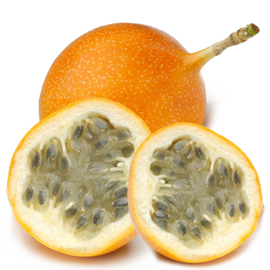
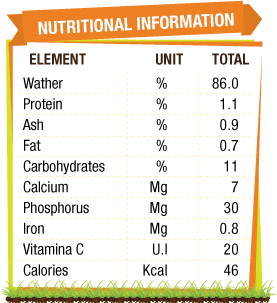
DESCRIPTION
The fruit is almost round, with a weight between 50 to 60 g and a diameter average of 5.7 cm. It has a resistant, smooth, thick bark.
••••••••••••••••••••••
MICROBIOLOGICAL SPECIFICATIONS Mesophiles count: 1000 UFC/g maximum count of fungi: 10 UFC/g maximum count of yeasts: 100 UFC/g maximum total coliforms N.M.P 200 UFC/g maximum fecal coliform N.M.P.0
••••••••••••••••••••••
PHYSICO-CHEMICAL SPECIFICATIONS
Total percentage of solids (° Brix): 49.5 - 50.5 relationship Brix / acidity: 3.24 - 4.18 PH (20 ° C): 2. 3 - 2.7 acidity (citric acid) %: 12.4 - 16.5
••••••••••••••••••••••
TYPO OF TREATMENT
The Gulupa is subjected to the stages of receipt, storage, selection, cleaning and disinfection, packaging and dispatch
••••••••••••••••••••••
STORAGE CONDITIONS
Temperature: Between 8 - 10 ° C relative humidity: between 65-70%
••••••••••••••••••••••
CONSUME
The Gulupa can eat raw, cutting it in half and eating the pulp with a spoon, can be eaten alone or with cream and sugar. It is also delicious in salads or juice, by pressing the pulp on a sieve and adding water. Sifted pulp, can also be used to make jellies, jams, sauces, cocktails and ice creams.
••••••••••••••••••••••
LIFE USEFUL UNDER CONDITIONS OF CONSERVATION 1 MONTH
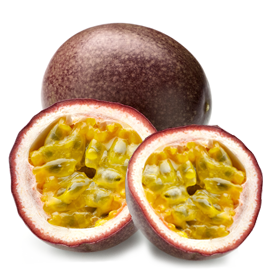
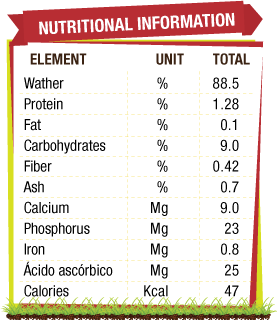
DESCRIPTION
The passion fruit belongs to the fruit of the passion. The fruit of form circular to oval weighs between 110 and 125 g and has approximately 6 or 7.5cms in diameter. When the ripe fruit, change of a deep green color to a bright yellow, its bark is thick and smooth, although over time it tends to creasing due to the natural process of maturation. Its interior contains numerous small edible seeds of black color.
••••••••••••••••••••••
MICROBIOLOGICAL SPECIFICATIONS Mesophiles count: 1000 UFC/g maximum count of fungi: 10 UFC/g maximum count of yeasts: 100 UFC/g maximum total coliforms N.M.P 200 UFC/g maximum fecal coliform N.M.P.0
••••••••••••••••••••••
PHYSICO-CHEMICAL SPECIFICATIONS Percentage of total solids (° Brix): 49.5 - 50.5 relationship Brix / acidity: 3.24 - 4.18 PH (20 ° C): 2.3 - 2.7 acidity (citric acid) %: 12.4 - 16.5
••••••••••••••••••••••
TYPE OF TREATMENT
The passion fruit undergoes the stages of receipt, storage, selection, cleaning, ventilation, packing and shipping.
••••••••••••••••••••••
CONDITIONS OF CONSERVATION
Temperature: Ambient relative humidity: environment. To avoid its maturation is recommended to ventilate it
••••••••••••••••••••••
CONSUME
This fruit can be consumed raw, cutting it in half, adding a little sugar to the pulp and eating it with a spoon. You can also prepare juices, nectars, yogurt, jams, liqueurs, ice cream and puddings.
••••••••••••••••••••••
LIFE USEFUL UNDER CONDITIONS OF CONSERVATION 12 TO 15 DAYS
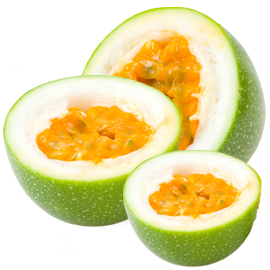
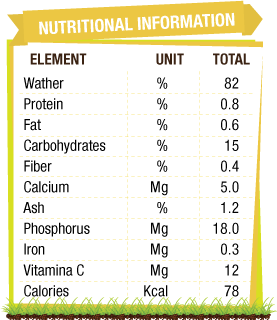
► COOL PITAHAYA
DESCRIPTION
It was discovered for the first time in the wild form by the Spanish conquerors in Mexico, Colombia, Central America and the West Indies, who gave him the name of "pitaya" meaning scaly fruit.
••••••••••••••••••••••
COLOR
With scales in bark, yellow its shiny and white pulp, with black seeds.
••••••••••••••••••••••
FLAVOR
The pitahaya is almost a portion of deliciously sweetened water.
••••••••••••••••••••••
BENEFITS
The fruit contains captina, who works as a cardiac tonic and nerve stimulant, addition to combat gastritis; the seed has oil which has laxative effect; the stem and flower heal diseases of the kidneys.
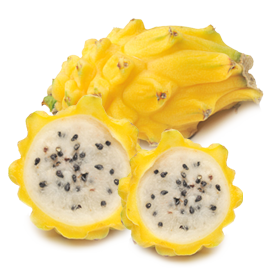
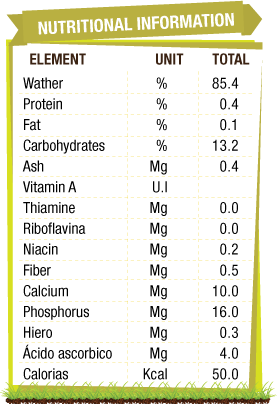
DESCRIPTION
The fruit is a Berry ovoid - apiculada. It has an average length of 7.3 cm, measured at its widest part between 5 and 6 cm. The average weight can vary between 100 and 150 g.
••••••••••••••••••••••
MICROBIOLOGICAL SPECIFICATIONS Count of mesofilos 100 UFC/g maximum yeasts and fungi 30 UFC/g maximum Total coliform N.M.P. < 3 fecal coliforms N.M.P. 0
••••••••••••••••••••••
PHYSICO-CHEMICAL SPECIFICATIONS Total percentage of solids (° Brix) 11.0-12.0 acidity (citric acid) %: 1.7-2.0 PH: 3.5 - 3.8 relationship Brix / acidity: 5.5-7.0
••••••••••••••••••••••
TYPE OF TREATMENT
The Tamarillo is subjected to the stages of receipt, storage, selection, cleaning, classification packaging and dispatch.
••••••••••••••••••••••
CONDITIONS OF CONSERVATION Temperature: Ambient relative humidity: environment
••••••••••••••••••••••
CONSUME
The Tamarillo can be consumed raw, peeled it and cutting it into slices or cutting it in half and consume the pulp with a spoon, can cover with sugar or salt depending on taste. Its use is common in juice.
••••••••••••••••••••••
USEFUL LIFE UNDER CONDITIONS OF CONSERVATION 14 DAYS
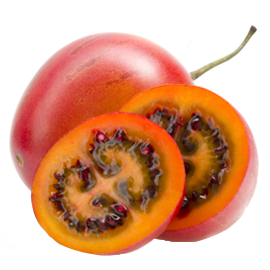
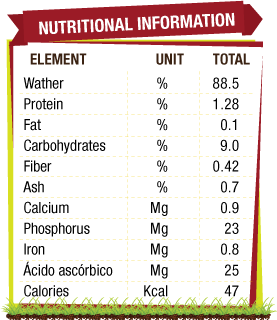
Copyright © 2015 CI Andes Export Company SAS


